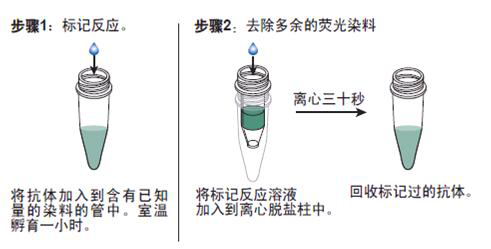
|

| 产地 | 进口、国产 |
| 品牌 | 上海莼试 |
| 保存条件 | Store at -20 °C |
| 货号 | CS11243 |
| 应用范围 | WB=1:100-500 ELISA=1:500-1000 IP=1:20-100 IHC-P=1:100-500 IHC-F=1:100-500 ICC=1:100-500 IF=1:100-500 |
| CAS编号 | |
| 抗体名 | Anti-Syntrophin-3 |
| 克隆性 | |
| 靶点 | 详见说明书 |
| 适应物种 | 详见说明书 |
| 形态 | 详见说明书 |
| 宿主 | 详见说明书 |
| 亚型 | IgG |
| 标识物 | 详见说明书 |
| 浓度 | 1mg/1ml% |
| 免疫原 | KLH conjugated synthetic peptide derived from human Syntrophin-3 |
产品订购信息:
英文名称 Anti-Syntrophin-3
中文名称 互养蛋白3抗体品牌
别 名 SNTB2_HUMAN; Beta-2-syntrophin; 59 kDa dystrophin-associated protein A1 basic component 2; Syntrophin 3; SNT3; Syntrophin-like; SNTL; SNTB2; D16S2531E; SNT2B2; SNTL; EST25263; SNT3.


浓 度 1mg/1ml
规 格 0.1ml/100μg 0.2ml/200μg
抗体来源 Rabbit
克隆类型 polyclonal
交叉反应 Human, Mouse, Rat, Dog, Pig, Cow
产品类型 一抗
研究领域 细胞生物 神经生物学 结合蛋白 跨膜蛋白 细胞膜蛋白
蛋白分子量 predicted molecular weight: 59kDa
性 状 Lyophilized or Liquid
免 疫 原 KLH conjugated synthetic peptide derived from human Syntrophin-3
亚 型 IgG
纯化方法 affinity purified by Protein A
储 存 液 Preservative: 15mM Sodium Azide, Constituents: 1% BSA, 0.01M PBS, pH 7.4
互养蛋白3抗体品牌 产品应用 WB=1:100-500 ELISA=1:500-1000 IP=1:20-100 IHC-P=1:100-500 IHC-F=1:100-500 ICC=1:100-500 IF=1:100-500
(石蜡切片需做抗原修复)
not yet tested in other applications.
optimal dilutions/concentrations should be determined by the end user.
保存条件 Store at -20 °C for one year. Avoid repeated freeze/thaw cycles. The lyophilized antibody is stable at room temperature for at least one month and for greater than a year when kept at -20°C. When reconstituted in sterile pH 7.4 0.01M PBS or diluent of antibody the antibody is stable for at least two weeks at 2-4 °C.
Important Note This product as supplied is intended for research use only, not for use in human, therapeutic or diagnostic applications.
产品介绍 Dystrophin is a large, rod-like cytoskeletal protein found at the inner surface of muscle fibers. Dystrophin is missing in Duchenne Muscular Dystrophy patients and is present in reduced amounts in Becker Muscular Dystrophy patients. The protein encoded by this gene is a peripheral membrane protein found associated with dystrophin and dystrophin-related proteins. This gene is a member of the syntrophin gene family, which contains at least two other structurally-related genes. [provided by RefSeq, Jul 2008].
Function : Adapter protein that binds to and probably organizes the subcellular localization of a variety of membrane proteins. May link various receptors to the actin cytoskeleton and the dystrophin glycoprotein complex. May play a role in the regulation of secretory granules via its interaction with PTPRN.
Subunit : Monomer and homodimer (Probable). Interacts with the other members of the syntrophin family: SNTA1 and SNTB1; and with the sodium channel proteins SCN4A and SCN5A. Interacts with SAST, MAST205, microtubules and microtubule-associated proteins. Interacts with the dystrophin protein DMD and related proteins DTNA and UTRN, and with the neuroregulin receptor ERBB4. Interacts with PTPRN when phosphorylated, protecting PTPRN from protein cleavage by CAPN1. Dephosphorylation upon insulin stimulation disrupts the interaction with PTPRN and results in the cleavage of PTPRN.
Subcellular Location : Membrane. Cytoplasmic vesicle, secretory vesicle membrane; Peripheral membrane protein. Cell junction. Cytoplasm, cytoskeleton. Note=Membrane-associated. In muscle, it is exclusively localized at the neuromuscular junction. In insulinoma cell line, it is enriched in secretory granules.
Tissue Specificity : Ubiquitous. Isoform 1 is the predominant isoform. Weak level of isoform 2 is present in all tested tissues, except in liver and heart where it is highly expressed.
Post-translational modifications : Phosphorylated. Partially dephosphorylated upon insulin stimulation.
Similarity : Belongs to the syntrophin family.
Contains 1 PDZ (DHR) domain.
Contains 2 PH domains.
Contains 1 SU (syntrophin unique) domain.
Database links : UniProtKB/Swiss-Prot: Q13425.1
NCBI Reference Sequence: NP_006741.1

Integrin AlphaE2/CD103 整合素αE2抗原Multi-class antibodies规格: 0.2ml
Anti-ADM/AM 肾上腺髓质素抗体Multi-class antibodies规格: 0.1ml
Rhesus antibody Rh Phospho-cdc2 (Tyr15) 磷酸化周期素依赖激酶2抗体 规格 0.1ml
X-GAL染色试剂盒 50ml Sigma原料
VDAC3 英文名称: 线粒体外膜孔蛋白3抗体(电压依赖阴离子通道蛋白3) 0.2ml
Drosha 英文名称: 核糖核酸酶3/Drosha抗体 0.2ml
Anti-ADM/AM 肾上腺髓质素抗体Multi-class antibodies规格: 0.1ml
Anti-phospho-CaMK2a (pThr286)/FITC 荧光素标记抗磷酸化钙/钙调素依赖蛋白激酶2α抗体IgGMulti-class antibodies规格: 0.2ml
Rabbit Anti-Guinea IgG/Gold 金标记兔抗豚鼠IgG (10nm/15nm)Multi-class antibodies规格: 0.5ml
成纤维细胞生长因子受体4抗体 Anti-FGFR4 0.1ml
Goat Anti-Mouse IgG/PE-CY5 PE-CY5标记的羊抗小鼠IgG 0.1ml
phospho-Fos B (Ser27) 英文名称: 磷酸化癌基因FOS蛋白B抗体 0.1ml
Rhesus antibody Rh phospho-STAT6(Tyr641) 磷酸化信号转导和转录激活因子6抗体 规格 0.1ml
Rabbit Anti-Guinea IgG/Gold 金标记兔抗豚鼠IgG (10nm/15nm)Multi-class antibodies规格: 0.5ml
STIP1 英文名称: 应激诱导磷蛋白1抗体 0.2ml
Endomucin 英文名称: 内皮粘蛋白EMCN抗体 0.2ml
阻抑基因1抗体 Anti-TSLC1 0.2ml
Anti-TRH/FITC 荧光素标记促甲状腺素释放激素抗体IgGMulti-class antibodies规格: 0.2ml
Rhesus antibody Rh Phospho-IRAK1 (Thr387) 磷酸化白介素-1受体相关激酶1抗体 规格 0.1ml
CA15-3 peptide 癌相关抗原抗原Multi-class antibodies规格: 0.5mg
KM3, 人细胞
HSCT6 大鼠肝星状细胞
FAM3D Others Human 人 FAM3D 人细胞裂解液 (阳性对照)
CM-R003大鼠Ⅱ型肺泡上皮细胞完全培养基100mL
人主动脉内皮细胞HAEC
细胞 人脑微内皮细胞完全培养基 100mL
CL-0023Ana-1(小鼠巨噬细胞)5×106cells/瓶×2
TDGF1 Others Rat 大鼠 Cripto / TDGF1 人细胞裂解液 (阳性对照)
小鼠卵巢颗粒细胞完全培养基 100mL
MLTC-1小鼠间质细胞瘤细胞 MLTC-1 mouse Leydig cell tumor RPMI-1640(GIBCO)+10%FBS
IL22 Protein Human 重组人 IL22 / IL-22 / Ierleukin 22 蛋白
SK-NEP-1(人肾母细胞瘤细胞) 5×106cells/瓶×2 PT-67(病毒转染小鼠细胞)
互养蛋白3抗体品牌 KM3, 人细胞
HSCT6 大鼠肝星状细胞
FAM3D Others Human 人 FAM3D 人细胞裂解液 (阳性对照)
CM-R003大鼠Ⅱ型肺泡上皮细胞完全培养基100mL
人主动脉内皮细胞HAEC
细胞 人脑微内皮细胞完全培养基 100mL

抗体的生物素化标记实验要点:
1. 互养蛋白3抗体品牌 如在反应混合液中有叠氮钠或游离氨基存在,会抑制标记反应。因此,蛋白质在反应前要对 0.1mol/L碳酸氢钠缓冲液或0.5mol/L硼酸缓冲液充分透析;
2.所用的NHSB及待生物素化蛋白质之间的分子比按蛋白质表面的ε-氨基的密度会有所不同,选择不当则影响标记的效率,应先用几个不同的分子比来筛选最适条件;
3.用NHSB量过量也是不利的,抗原的结合位点可能因此被封闭,导致抗体失活;
4.由于抗体的氨基不易接近可能造成生物素化不足,此时可加入去污剂如 Triton x-100, Tween20等;
5.当游离ε-氨基(赖氨酸残基的氨基)存在于抗体的抗原结合位点时,或位于酶的催化位点时,生物素化会降低或损伤抗体蛋白的结合力或活性;
6.生物素还可能与不同的功能基团,如羰基、氨基、巯基、异咪唑基及苯酚基,也可与糖基共价结合;
7.交联反应后,应充分透析,否则,残余的生物素会对生物素化抗体与亲和素的结合产生竞争作用;
8.在细胞的荧光标记实验中,中和亲和素的本底低,但由于链霉亲和素含有少量正电荷,故对某些细胞可导致高本底。
抗体的鉴定:
1)互养蛋白3抗体品牌 抗体的效价鉴定:不管是用于诊断还是用于,制备抗体的目的都是要求较高效价。不同的抗原制备的抗体,要求的效价不一。鉴定效价的方法很多,包括有试管凝集反应,琼脂扩散试验,酶联免疫吸附试验等。常用的抗原所制备的抗体一般都有约成的鉴定效价的方法,以资比较。如制备抗抗体的效价,一般就采用琼脂扩散试验来鉴定。
2)抗体的特异性鉴定:抗体的特异性是指与相应抗原或近似抗原物质的识别能力。抗体的特异性高,它的识别能力就强。衡量特异性通常以交叉反应率来表示。交叉反应率可用竞争抑制试验测定。以不同浓度抗原和近似抗原分别做竞争抑制曲线,计算各自的结合率,求出各自在IC50时的浓度,并按公式计算交叉反应率。
如果所用抗原浓度IC50浓度为pg/管,而一些近似抗原物质的IC50浓度几乎是无穷大时,表示这一抗血清与其他抗原物质的交叉反应率近似为0,即该血清的特异性较好。
3)抗体亲和力:是指抗体和抗原结合的牢固程度。亲和力的高低是由抗原分子的大小,抗体分子的结合位点与抗原决定簇之间立体构型的合适度决定的。有助于维持抗原抗体复合物稳定的分子间力有氢键,疏水键,侧链相反电荷基因的库仑力,范德华力和空间斥力。亲和力常以亲和常数K表示,K的单位是L/mol。抗体亲和力的测定对抗体的筛选,确定抗体的用途,验证抗体的均一性等均有重要意义。